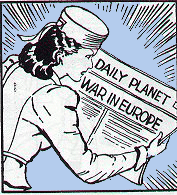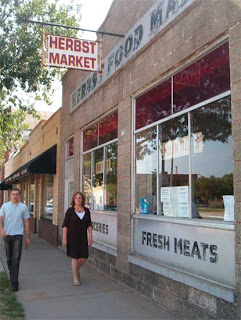Anonymous has left a new comment on your post "Other City Sidewalks: Babylon NY":
Wow, you really don't seem to get Babylon Village, do you. I live in town and love it. I moved from Brooklyn after too many years of cramped spaces. To me, the Village has "just enough" of everything for me to offer a very balanced experience between small town and more urban offerings. I think that to measure it in terms of how urban it is misses the point completely about why people live there.
Well, honestly, I agree completely with Anonymous. I don't really seem to get Babylon Village. I mean, I kind of understand why people might want to live there... its like an authentic suburb. You can have your house/yard and eat it too, driving around on the South Shore. In Caro's book on Moses, he describes the historic fishing/working classes along Long Island's South shore, and how different these little villages were from the wealthy Gatsby enclaves on the North side of the island. of course, this is before Moses facilitated Arthur Levitt's potato field alchemy, turning the center of the island into a repeating series of stripmalls, big boxes, outlets, and LIE exits.
My point is that Babylon Village is close enough to the city, conviently on a LIRR stop, to allow for some denser development. Why isn't there a vibrant street life in Babylon? Why aren't there sidewalks? Why aren't there at least a few apartment buildings? Mixed-use developments? According to Caro, people in these little Long Island villages have a long history of trying to keep 'city people' out of their communities, for whatever reason. My proposition is that they're still doing it. The fact of the matter: walking on Babylon sidewalks sucks.
My friend Ann wrote about my New London diary:
My grandparents used to live in New London and used that same library! They didn't know each other when they lived there because he was 5 years old, so hung out in the more adult reading section and grandma was in the children's section. Thanks for reminding me of this part of my family history, Bill. I have New London blood in me.
One of the things I didn't mention about my New London visit was that I got horribly horribly lost. I parked the car somewhere in a 2 hr. surface parking lot, somewhere surrounded old by brick buildings, and started wandering around the city, eventually finding people, corner stores, a coffee shop, train tracks, the Thames River, the old town square, the Patrick Henry schoolhouse (or something), and a few bench bandits. But, at some point I had to re-find my car, and I had this vague notion it was somewhere up one of the hills that surround this river valley town.
I walked up and up and around the hills of the city, passing by this familiar-looking grey church a half-dozen times, looking and looking for the car, wandering down used-car lot streets, past stoplights, abandoned buildings, brambles, and gullys.
I eventually found the New London library, went inside, and asked the librarians to help me (help me please!), saying "I lost my car. It's in a parking lot next to a little red hut. Do you know where that is?" They smiled, and pointed me toward the middle of town, nowhere near where I'd thought it was. When I got there, I found a parking ticket on the windshield. I guess it's easy to enforce parking laws in a town with no people.
Herr Engen has left a new comment on your post "My Way or the Skyway":
The skyways do need to go, but with a lack of money the first thing to do is to close them. Then slowly dismantle the system. To those that say they add to city vitality they must have never been to another city. Separating work and nightlife crowds into 2 sectors cuts the consumer base in half. Walking downtown is, currently, quite boring. The buildings are not inviting, both as a result of their hugeness and...shit, what does this blog matter, no one will read it anyway!
There are so many ways in which we agree, Herr Engen. Yes, this blog is useless. Yes, the buildings have a brutal hugeness that stomps on humanity... In fact, that's the point of a skyscraper. It's meant to inspire and impose as it pokes the clouds. But that doesn't mean the part we use and see the most, the bottom two floors, shouldn't be interesting, have windows, gargoyles, marble, or any number of detailed details. And the more I think about and walk about skyways, the more I hate them. Can't we all just get along? Can't we all just walk along the same damn street?
Minnesotans are so proud of their cold, cold climate! Drop a Minnesotan into a cosmopolitan party, and within 90 seconds they'll be describing the cold, cold weather, puffing their chests and rubbing their hands. And, if there's one we should be proud of, its that really know how to bundle up.
Well, skyways are weak. They're entirely neutered. Either stop bragging about your winters, or get out of the skyways, folks. What do you think those boots are for?
I was talking with a friend of mine last night who used to walk the skyways, once in a while, from the Steven's Square area down to his job at the Graves 601. (He doesn't work there any more.) He told this tale of a group of people, walking these artifical streets at 6:30 in the morning, getting trapped on the Skyway Level of the TCF Building, let in thourgh a door that wouldn't re-open. All the skyway doors were locked, and this group of people wandered around the building for quite some time, searching in vain the rooms of carpeted, blank mall-space for a way out, until finally getting into the one working elevator and taking it down to an exit-able floor.
As Herr Engen says, skyways:
...separate people into upper and lower classes
...split the customer market for any business in half
...make Minnesotan weather-boasting awfully hypocritical
...look dumb, for the most part
Skyways should go the way of the Metrodome, and head to that great Modernist utopia in the sky.
CitySlicker has left a new comment on your post "Sidewalk Semiotics: "Auto Mobility"":
I agree with the authors you read, as most true urbanists do. But you sometimes stop short of committing to what you really want to say, that automobilization is the opposite of urbanization. There are many things I like about your writing, but the biggest is probably how you manage to get your point across without pissing anyone off! Sometimes I find that hard to do after I've been biking through downtown, lulled by the block-long walls surrounding me and almost squashed by F-350s.
I know this girl with some notable punk tendencies, who was biking one night down Hennepin Avenue on a weekend, when some clubbing girls in a white car cut her off, and threw McDonalds litter at her and her bicycle. When the car came to a stopsign, she took her U-lock and smashed in their side window. (I think she spent the night in jail, too!) (This kind of thing was mentioned in this great bike article from MSP Magazine, too.)
Was this wise? Justifiable? Fun?
I don't really hate cars, though one time a grey Jeep mini-SUV totally cut me off on SE Como, turning right in front of me, barely avoiding my front wheel. I flipped them off, which was kind of a first for me.
Don't get me wrong, I hate cars as much as the next guy. I especially hate road rage.... it totally pisses me off! And on snowy days like today, I love seeing people struggle up a hill, clog the intersections, scrape their windsheilds, and spin their tires in the increasingly drifting whitebanks. Snow covers everything, making curbs invisible, erasing the border between sidewalk and street. Everything disappears, lines are no more.
That said, seeing cars in accidents freaks me out, on the freeway or on the avenue, but sometimes I think there's a kind of terrible justice in it. And I really, really love seeing bumper-to-bumper traffic from a freeway bridge.
But mostly, cars make me sad. In the morning I stand on my streetcorner, waiting for the bus, and watching as car after car pull up to the stop sign, and after a microscopic pause, drive off. I have a little second, there, where I can see into their windows and watch their faces. Maybe one out of a thousand will be smiling.
These comments all regarding this post on the great TC divide:
To some extent I would agree. One could say that the different way in which each of the Twin Cities has grown up has endowed St. Paul with more desirable urban neighborhoods. What Minneapolis has, which has had been more of a challenge to foster in St. Paul, are large areas of its old central business district (see the Warehouse District) transformed into new and desirable neighborhoods.
Charlie Quimby said...
St. Paul is more stable, for reasons good and bad.
Another age difference, I'd wager, is that in St. Paul, street cars cemented what was there, while in Minneapolis, they influenced development. (See history of Kings Highway area, etc.)
CitySlicker said...
The author makes good arguments about why the cities are what they are. Does anyone associate Mpls with families and tradition? No. We associate it with partying and skyscrapers. The comment about the streetcars is spot on. That's why it would be so much easier to reintroduce streetcars to St. Paul!
What is the difference between Minneapolis and Saint Paul?
I once took a non-scientific survey of this, asking a ton of random strangers, and the most common answer was that "Saint Paul is neighborhoody," and that it's a "big small town", while Minneapolis was a "small big city". What makes it more stable? Are people just that much less likely to want to try something new? Is that why its hard as hell for a new fancy restaurant to start up in the Capital City?
I'm afraid I don't know the history of the King's Highway area. Anyone care to enlighten me?
Streetcars in Saint Paul should go along Grand Avenue? West 7th? Como Avenue? Robert Street? Rice Street? (That's the order I'd build them.)

































